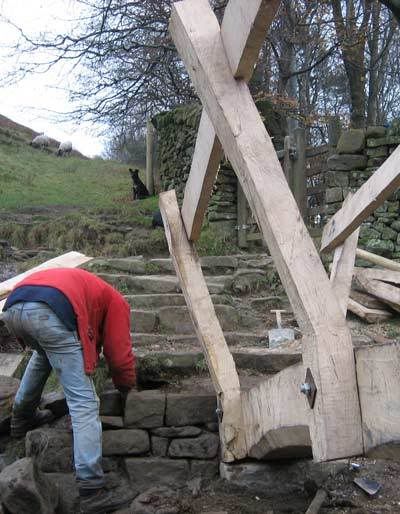The spoons are our hobby but this is the day job, just finished today. Its made from a single sweet chestnut felled in the ajoining plantation.









What's the bit you're standing on made of?
Mike
If you want to see it, come to the wonderful Peak District! It's on the main footpath out of Edale that goes up Grindsbrook onto Kinder Scout - just where it crosses Golden Clough.
Take a camera and take a snap of the abuttments please!


Nothing used to "set out" the joinery, there isn't a straight line or right angle on the thing to work from..everything is just done by eye. Uprights are not housed or jointed just butted up and with a big steel threaded bar right through from one side to the other, my thinking is that with the fixing to the rail at the top they are not going to swivel sideways.
 There work still stand's. My neighbour's house was built that way and Henry VIII was the king then. One problem you will encounter as your timbers begin to dry out is that they will shrink (as much as half an inch or more on the floor beam) and the stantion's will shrink as well, so those butted "joints" will loosen in time. Scribe carpentry makes allowance for shrinkage so it doesnt compromise the structural integrity. If you had housed them even in a shallow 1/2 inch housing, this would have made it more structurally sound. Your relying entirely on one fixing (single bolts). Those cross bolt's will need checking and tightening a few times to alleviate that.
There work still stand's. My neighbour's house was built that way and Henry VIII was the king then. One problem you will encounter as your timbers begin to dry out is that they will shrink (as much as half an inch or more on the floor beam) and the stantion's will shrink as well, so those butted "joints" will loosen in time. Scribe carpentry makes allowance for shrinkage so it doesnt compromise the structural integrity. If you had housed them even in a shallow 1/2 inch housing, this would have made it more structurally sound. Your relying entirely on one fixing (single bolts). Those cross bolt's will need checking and tightening a few times to alleviate that.